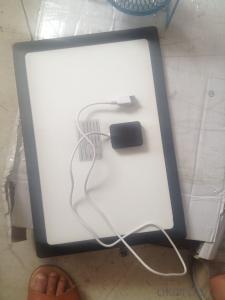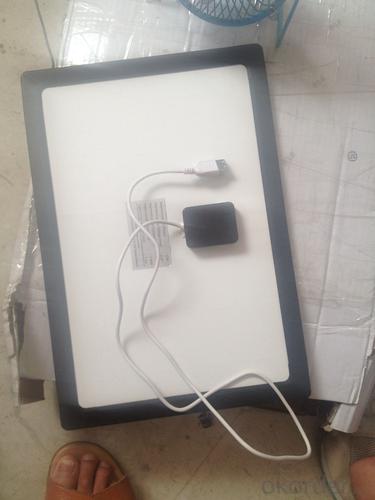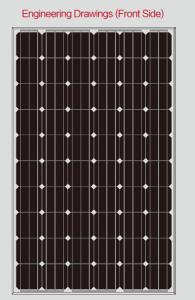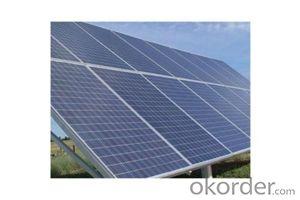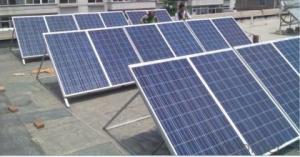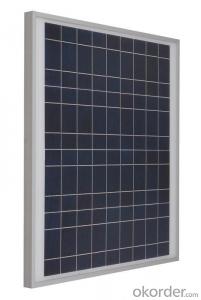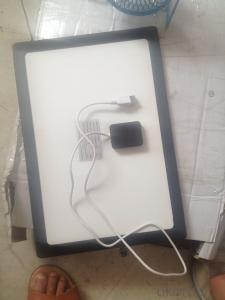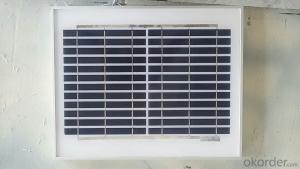Solar Panels Miami Miami Fl - Polycrystalline Solar Panels 45W for Small Solar Systems
- Loading Port:
- Shanghai
- Payment Terms:
- TT OR LC
- Min Order Qty:
- 10000 watt
- Supply Capability:
- 50000000 watt/month
OKorder Service Pledge
OKorder Financial Service
You Might Also Like
Product Description
Solar Polycrystalline Series Panels
Introduction of Polycrystalline Solar Panels
CNBM Solar photovoltaic (PV) Panel is designed for large electrical power requirements. It is the optimal choice for both on-grid and off-grid power systems. CNBM Solar panel offers high performance of power per square foot of solar array. Polycrystalline silicon(c-Si): often made using the Czochralski process. Single-crystal wafer cells tend to be expensive, and because they are cut from cylindrical ingots, do not completely cover a square solar cell module without a substantial waste of refined silicon. Hence most c-Si panels have uncovered gaps at the four corners of the cells.
Characteristics of Polycrystalline Solar Panels
I Solar Cell : High efficiency crystalline solar cell. Even if under the weak light, the solar module can produce maximum power output.
II Tempered glass (toughened glass): Anti-reflecting coating and high transmission rate glass increase the power output and mechanical strength of solar module.
III EVA and TPT: Using high quality EVA and TPT to prevent destroying and water.
IV AI frame: Without screw, corner connection. 6 holes on the frame can be installed easily.
V Junction box: Multi function junction box with water proof.
VI Long lifetime: ≥25 years; Less power decrease
VII Good performance of preventing from atrocious weather such as wind and hails.
VIII Resisting moisture and etching effectively, not effected by geology.
Standard Test Conditions of Polycrystalline Solar Panels
The opto-electrical specifications shown below are stabilized values being measured at Standard Test Conditions, Irradiance: 1000W/m2, Spectrum: AM1.5 at 25°C, The info below is subject to manufacturing tolerances. Where appropriate minutes of measurement are available and are used for the dimensioning of the installation.
Advantages of Polycrystalline Solar Panels
1.High reliability with guaranteed -3% to +5% power output tolerance, ensuring return on investment
2. High conversion efficiency based on leading innovative photovoltaic technologies
3. Withstands high wind-pressure and snow load, and extreme temperature variations
4. Attractive appearance Unique frame design, high mechanical strength, and easy Installation
Characteristics of Polycrystalline Solar Panels
Max Power Voltage Vmp (V) | 17.4V | 17.6 V |
Max Power Current Imp (A) | 2.59A | 2.85A |
Open Circuit Voltage Voc (V) | 22.4V | 22.5V |
Short Circuit Current Isc (A) | 2.77A | 3.04A |
Max Power Pm (W) | 45W | 50W |
Temperature Coefficient of Cells
NOCT | 47℃±2℃ |
Temperature Coefficients of Isc (%/℃) | 0.06 |
Temperature Coefficients of Voc (%/℃) | -0.33 |
Temperature Coefficients of Pmp (%/℃) | -0.45 |
Mechanical Data Solar Polycrystalline Series
Power | 45W/50W |
Dimension | 700×510×30mm |
Weight | 4.5 kg |
Tolerance | ±3% |
The dimension of the modules can be changed according to the demand of clients Limits.
Operating Temperature | –45 °C to +80°C |
Storage Temperature | –45 °C to +80°C |
Max System Voltage | 700V |
Guarantee Solar Polycrystalline Series Panels
Products Guarantee | 2 years free from defects in materials and workmanship |
Performance Guarantee | No less than 90% within 10yrs and no less than 80% within 25yrs |
Certificates | IEC, ISO, TUV, CE |
Dimension of Solar Polycrystalline Series Panels
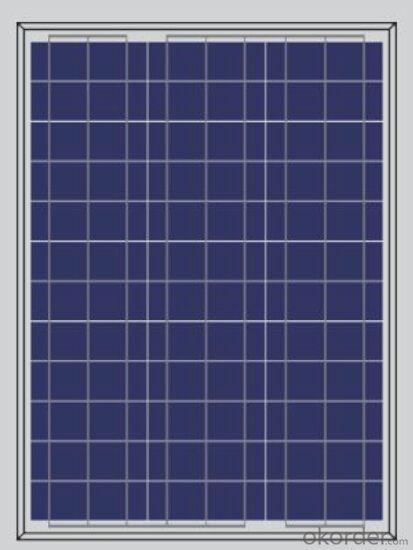
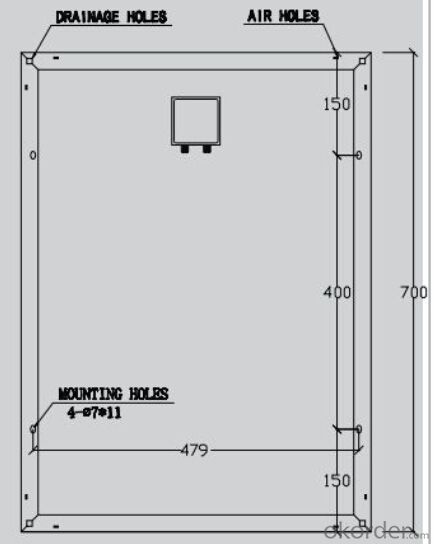
FAQ
We have organized several common questions for our clients,may help you sincerely:
1. What’s price per watt?
A: It’s depends on the quantity, delivery date and payment terms of the order. We can talk further about the detail price issue. Our products is high quality with lower price level.
2. Can you tell me the parameter of your solar panels?
We have different series of cells with different power output, both from c-si to a-si. Please take our specification sheet for your reference.
3. How do you pack your products?
We have rich experience on how to pack the panels to make sure the safety on shipment when it arrives at the destination.
4. What is your warranty system?
Our product performance guarantees for 25 years
• 12 years guarantee for workmanship
• Timeliness of delivery
• Quality Products certified (TÜV, UL, CE, ISO)
5. How do you pack your products?
We have rich experience on how to pack the panels to make sure the safety on shipment when it arrives at the destination.
- Q: What is the payback period for solar panels?
- The payback period for solar panels can vary depending on factors such as the initial cost of installation, location, energy usage, and available incentives. However, on average, solar panels tend to have a payback period of about 5 to 10 years.
- Q: How do solar panels reduce carbon emissions?
- Solar panels reduce carbon emissions by converting sunlight into electricity without burning fossil fuels. When sunlight hits the solar panels, it triggers a process called the photovoltaic effect, which generates electrical energy. This renewable energy source eliminates the need for traditional power plants that rely on burning fossil fuels, such as coal or natural gas, which release carbon dioxide and other greenhouse gases into the atmosphere. By harnessing solar energy, solar panels enable a cleaner and more sustainable electricity generation, significantly reducing carbon emissions and mitigating the harmful impacts of climate change.
- Q: What is the impact of snow accumulation on solar panels' performance?
- Snow accumulation on solar panels can have a significant impact on their performance. When snow covers the panels, it blocks sunlight from reaching the photovoltaic cells, reducing their ability to generate electricity. Additionally, the weight of the snow can put stress on the panels and potentially damage them. However, some modern solar panels are designed with anti-reflective coatings and tilted surfaces to minimize snow accumulation and aid in self-cleaning. In regions with heavy snowfall, regular cleaning or snow removal may be necessary to maintain optimal solar panel performance.
- Q: If a solar panel (using 36 3x6 solar cells) puts out 60 watts, how many panels would I need (for a house) if I use a max of 2300 kWh in a month? I checked my electric usage for the past 2 years and the kWh is usually lower but I wanted to use the most kWh used (2300) for my question. Thanks!
- One key piece of information missing is the average number of peak sun hours per day. This will vary by location. It is latitude, regional weather, and site shading must be considered. Another consideration is the loses. The 60 watt solar panel is a DC voltage. The 2300 kWh is for the AC power consumed. There are loses in the inverter to change the electricity from DC to AC. There are also loses for wire resistance, soiling of the panels, wire resistance, etc. To work out an example of the math, I'll use 5 peak sun hours and a total efficiency of 80%. The math can be worked out as a single formula but I'll break it into steps for you. (2300 kwh/month)(month/30.4 days) = 75.65 kWh/day (60 W)(5 psh)(80%) = 240 Wh/day = 0.24 kWh/day/panel # of panels needed = Energy use / Energy generated (75.65 kWh/day) / (0.24 kWh/day/panel) = 36 panels.
- Q: Can solar panels be used in areas with high levels of saltwater?
- Yes, solar panels can be used in areas with high levels of saltwater. However, it is important to choose solar panels specifically designed for such environments, as regular panels may corrode or deteriorate due to the salt content. Specialized panels with protective coatings and materials are available to ensure their longevity and optimal performance in saltwater areas.
- Q: When you add a load resistor to a PV panel (Solar panel) of 00 ohms what happens to the voltage produced from the cellAlso, as the resistance increases, how does this affect the output voltage
- Look at the graph data that looks like a rotated L. That is what voltage as a function of current characteristically behaves. The highest voltage value is called open circuit voltage (Voc). The current at lowest voltage value is called short circuit current (Isc). If you notice, a second curve is plotted that looks like a hill. That curve is power output as a function of voltage. At the peak of said hill, you get the most utility of your PV module, as you output the maximum power possible, and that is the nameplate value for the PV module's power rating.
- Q: Are there any fire hazards associated with solar panels?
- Yes, there are potential fire hazards associated with solar panels, although they are relatively rare. These hazards can occur due to faulty installation, wiring issues, or manufacturing defects. However, with proper installation, regular maintenance, and adherence to safety regulations, the risk of fire can be minimized.
- Q: Can solar panels be used in areas with high wind speeds?
- Yes, solar panels can be used in areas with high wind speeds. However, it is important to ensure that the solar panel installation is designed and constructed to withstand strong winds. This can be achieved through proper mounting and anchoring techniques, as well as using wind-resistant materials. Additionally, tilt angles and panel positioning can be optimized to reduce the effects of wind resistance.
- Q: Do solar panels work at night?
- No, solar panels do not work at night because they require sunlight to generate electricity.
- Q: How do solar panels affect the environment?
- Solar panels have a positive impact on the environment as they produce clean, renewable energy without emitting harmful greenhouse gases. They help reduce air pollution, combat climate change, and conserve natural resources by decreasing our reliance on fossil fuels. Additionally, solar panels have a minimal environmental footprint during their operation and can be recycled at the end of their lifespan, making them a sustainable energy choice.
Send your message to us
Solar Panels Miami Miami Fl - Polycrystalline Solar Panels 45W for Small Solar Systems
- Loading Port:
- Shanghai
- Payment Terms:
- TT OR LC
- Min Order Qty:
- 10000 watt
- Supply Capability:
- 50000000 watt/month
OKorder Service Pledge
OKorder Financial Service
Similar products
Hot products
Hot Searches
Related keywords
